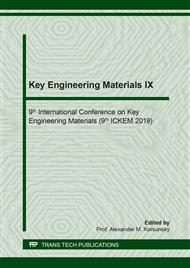[1]
H. Fazli, A.Y. Mohd Yassin, N. Shafiq, and W. Teo, Pull-off testing as an interfacial bond strength assessment of CFRP-concrete interface exposed to a marine environment,, International Journal of Adhesion and Adhesives, vol. 84, p.335 – 342, (2018).
DOI: 10.1016/j.ijadhadh.2018.04.015
Google Scholar
[2]
R. Ghavidel, R. Madandoust, and M.M. Ranjbar, Reliability of pull-off test for steel fibre reinforced self-compacting concrete,, Measurement, vol. 73, p.628 – 639, (2015).
DOI: 10.1016/j.measurement.2015.06.013
Google Scholar
[3]
E. Bonaldo, J.A.O. Barros, and P.B. Lourenco, Bond characterization between concrete substrate and repairing SFRC using pull-off testing,, International Journal of Adhesion & Adhesives, vol. 25, p.463 – 474, (2005).
DOI: 10.1016/j.ijadhadh.2005.01.002
Google Scholar
[4]
N.M.M. Ramos, M.L. Simoes, , J.M.P.Q Delgado, and V.P. Freitas, Reliability of the pull-off test for in situ evaluation of adhesion strength,, Construction and Building Materials, vol. 31, p.86 – 93, (2012).
DOI: 10.1016/j.conbuildmat.2011.12.097
Google Scholar
[5]
M.N. Noorsuhada, Structural health monitoring through acoustic emission,, in Eco-Efficient Repair and Rehabilitation of Concrete Infrastructures, F. Pacheco-Torgal, Robert E. Melchers, Xianming Shi, Nele De Belie, Kim Van Tittelboom, and Andrés Sáez, Woodhead Publishing Series in Civil and Structural Engineering, 2018, pp.123-146.
DOI: 10.1016/b978-0-08-102181-1.00006-x
Google Scholar
[6]
E. ASTM 1316, Standard terminology for nondestructive examinations,, ASTM International, (2006).
Google Scholar
[7]
M. Huang, L. Jiang, P.K. Liaw, C.R. Brooks, R. Seeley, and D.L. Klarstrom, Using acoustic emission in fatigue and fracture materials research,, Journal of Materials, vol. 50, no. 11, (1999).
Google Scholar
[8]
BS 1881-125, Testing concrete. Methods for mixing and sampling fresh concrete in the laboratory,, British Standard Ltd., (1986).
Google Scholar
[9]
W.T. Lee, Y.J. Chiou, and M.H. Shih, Reinforced concrete beam–column joint strengthened with carbon fiber reinforced polymer,, Composite Structures, vol. 92, p.48–60, (2010).
DOI: 10.1016/j.compstruct.2009.06.011
Google Scholar
[10]
M.N. Noorsuhada, An overview on fatigue damage assessment of reinforced concrete structures with the aid of acoustic emission technique,, Construction and Building Materials, vol. 112, p.429 – 439, (2016).
DOI: 10.1016/j.conbuildmat.2016.02.206
Google Scholar
[11]
N. Md Nor, A. Ibrahim, N. Muhamad Bunnori, and H. Mohd Saman, Acoustic emission signal for fatigue crack classification on reinforced concrete beam,, Construction and Building Materials, vol. 49, pp.583-590, (2013).
DOI: 10.1016/j.conbuildmat.2013.08.057
Google Scholar
[12]
N. Md Nor, A. Ibrahim, N. Muhamad Bunnori, H. Mohd Saman, S.N. Mat Saliah, and S. Shahidan, Diagnostic of fatigue damage severity on reinforced concrete beam using acoustic emission Technique,, Engineering Failure Analysis, vol. 41, pp.1-9, (2014).
DOI: 10.1016/j.engfailanal.2013.07.015
Google Scholar
[13]
O.R. Mata, and R.A. Atadero, Evaluation of pull-off tests as a FRP-concrete bond testing method in the laboratory and field,, Practice Periodical on Structural Design and Construction, vol. 19, no. 2, (2014).
DOI: 10.1061/(asce)sc.1943-5576.0000170
Google Scholar
[14]
N. Md Nor, and S.N. Mat Saliah, Acoustic signal strength for damage evaluation of reinforced concrete beam, ARPN Journal of Engineering and Applied Sciences, vol. 11, no. 4, (2016).
Google Scholar
[15]
J. Xu, Nondestructive evaluation of prestressed concrete structures by means of acoustic emissions monitoring,, PhD Thesis. Auburn University, (2008).
Google Scholar
[16]
A. Pollock, Inspecting bridges with acoustic emission-inspection details about in service steel bridges and monitoring weld operations: Application guidelines,, Physical Acoustic Corporation, (1995).
Google Scholar
[17]
M. Hrairi, Statistical signal processing and sorting for acoustic emission monitoring of high-temperature pressure components,, Experimental Mechanics, p.35–43. (2009).
DOI: 10.1111/j.1747-1567.2008.00418.x
Google Scholar
[18]
T.J. Fowler, and E. Gray, Development of as acoustic emission test for FRP equipment,, American Society of Civil Engineers convention and exposition, (1979).
Google Scholar


